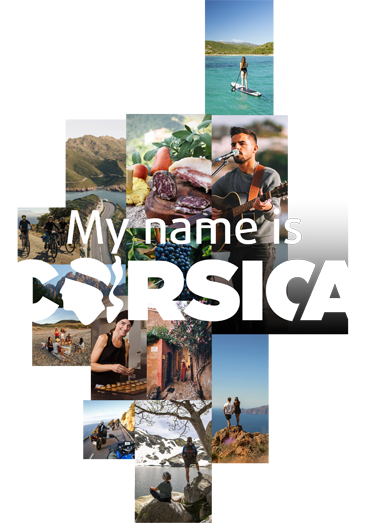Rechercher...
Explore Corsica
Domaine de Torraccia
Nature at the service of wine

Nature, peace and space generate and energise life itself.
The two-storey cellar, a square building dating from the 1960s, also serves as a tasting room. Visitors are welcomed into a warm and welcoming environment. To the right of the entrance are the massive concrete vats, enamelled white and red. To the left, a linear cabinet flanked by refrigerators serves as a sales point. The back room is fitted out with modern equipment and the basement is given over to the maturing cellar. On the walls hang colourful and eclectic works by Lucie, the daughter of Marc Imbert, the owner of the premises, as well as humorous sketches by well-known artists. Against this baroque backdrop, we catch a glimpse of the winemaker busy packing bottles for customers and answering their questions.
 ©MASTERCHEF
©MASTERCHEF
A PHILOSOPHY TO DISCOVER
"My father Christian Imbert fell in love with the estate on his return from Chad in 1964, where he was exporting agricultural goods. He cleared the scrubland and planted 43 hectares of vines, mainly native varieties, contrary to the fashion at the time. In 1976, he set up the Union des Vignerons de l'Appellation Corse. It was a group of passionate winegrower-owners who wanted to defend indigenous grape varieties, respect for the land and the quality of the wines produced," explains Marc. "In 2008, my brother Christophe and I took over the estate with the same ethos. The vines are grown organically in a natural setting. They retain their natural balance and produce healthy grapes. The aromas of the biodiversity of the maquis are deposited on the bloom (indigenous yeasts) and passed on to the grapes. The diversity of the granite arena soils provides the mineral energy that is essential to the maturing of the estate's wines," he adds.
A VINEYARD BETWEEN SEA AND MOUNTAINS
The characteristics of the estate's wines come from the vineyards planted with Vermentinu white grapes and Niellucciu, Sciaccarellu, Syrah, Grenache and Cinsault red grapes. The vineyards are planted on slopes of granite arena at the heart of the densely vegetated area and its teeming ecosystem. "For a long time, we ignored the power of dew on the vine. Our vineyards, located between the sea and the mountains, benefit from a very high level of humidity. This is essential in summer, and we help the vines to absorb it. Our treatments are homeopathic, as the plant needs us to let it live", explains the winemaker. The grapes here are harvested by hand, juggling the different maturities. The wines are matured in concrete and stainless-steel vats and 228-litre oak barrels. Their styles are fine, well balanced, lively and energetic, and their aromas are highly expressive of the maquis. The rosés and whites are lively and fruity, while the reds are round on the palate and age well over a decade. The estate offers a fine range of old vintages and wines for laying down.
The winemaker experimented with the length of time the wine was kept in storage, going from four to two years, and then opting for four years to preserve the wine's bouquet. He has eliminated his stock of old vintages, with the exception of magnums dating back to the 2000 vintage. Today, he's thinking of reworking the ageing process. He has discovered that Grenache tends to 'pinot' with age. The 2015, 2016 and 2019 vintages are intended for laying down, and the 2020 will soon be waxed.
AN ESTATE THAT ADAPTS
"In recent years, climate change has forced us to adapt our methods. Paradoxically, we're finding creative opportunities in terms of blending," explains Marc Imbert. As a result, the range of cuvées has expanded, with the two original cuvées, Tradition and Oriu, now joined by Alligria and Salvaticu. The granitic influence brings minerality and finesse to the wine. When the granite minerality is lacking, maturing in suitable barrels gives the wine its fine, structuring bitterness. The blends come from the three types of granite - grey, pink and blue - which provide distinct and complementary mineralities. The crumbly granite and the rainfall accentuate and differentiate the mineral expressions. To paraphrase Olivier Poussier, voted World's Best Sommelier in 2000, "to have a good water regime, you have to work the soil thoroughly".
TASTING TIME
Oriu Blanc 2022 - The cuvée that explores the terroir. Pale gold colour with brilliant highlights, powerful aromas of white flowers, pear in syrup, taut mineral expression, lovely bitters, fine salinity. Beautifully balanced.
Domaine Torraccia Rouge 2018 - Ruby colour, beautiful aromatic expression, red fruit, mastic, rockrose, cocoa, well-balanced, morello cherry structure, lovely liveliness, mellow tannins, saline finish. An elegant wine for a meal.
Salvaticu 2018 Blanc n°2 - Brilliant gold colour, a generous wine with smoky, toasty notes, citrus, botanical infusions, fresh acidity, lovely mineral tension, saline finish. A complex, energetic, aromatic gastronomic wine.
 ©MASTERCHEF
©MASTERCHEF
Domaine de Torraccia
20137 Lecci
Tél. : 04 95 71 43 50
Locate
powered by cd-media.fr



